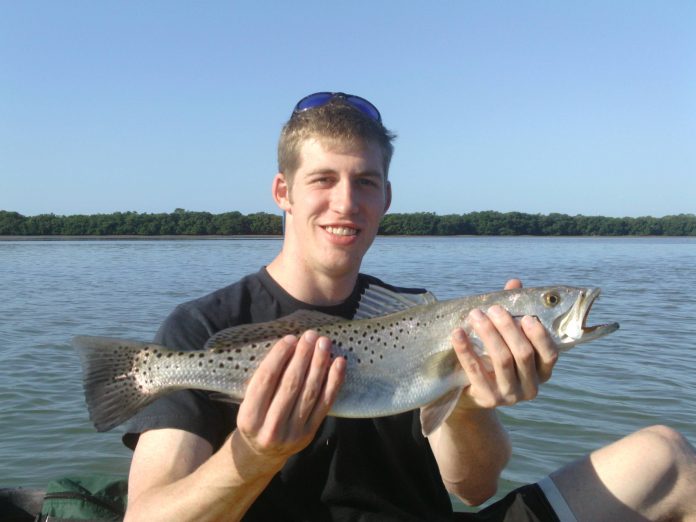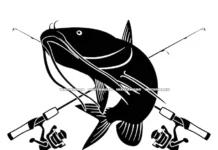Neil Taylor, Capmel.com Site Administrator, owner of Strike Three Kayak Fishing- instructional kayak fishing charters
October 2011
October is like “Christmas come early” for the people who sit out the summer months waiting for more comfortable fishing weather. This month is a great time to intercept trout feeding strongly and well into the midday hours, a shift from the previous seven months of inactivity during times of peak sunshine. Their abundance and their cooperative nature to eat for the anglers is the biggest reason for their popularity. It is not all that unusual to sit on a school of trout and catch dozens in a short period of time. Trout are a good fish to eat, a little softer meat than other species but good in a frying pan or oven. A member of the drum family, the best eating trout are the ones that are in the slot limit. The ones that get over 22-inches are great baby-makers and honestly don’t have the better eating flesh that the slot fish have. Bigger trout (over 20-inches) put up a pretty good fight! If you don’t have medium to ultralight rods: Go get one and go after trout!
Targeting speckled trout
This is light tackle fun and they will eat lures just as easily as they will natural baits. It really comes down to several factors: Locating the trout; Moving lures down where they eat. One-eighth to one-quarter ounce jigheads with 3 or 5-inch plastic tails such as the 12 Fathom Mullet and SlamR’s are great trout catchers. The equation for locating trout is fairly easy. Prospect areas with 3 to 10-feet in depth and seagrass bottom. The presence of current is a bonus but not a necessity. The best way to proceed is to set up a drift and start casting, letting the wind or current carry you across an area you expect to locate them. Once a decent trout is hooked, quickly deploy an anchor to set up and work over the rest of the fish that may be there. The goal for moving the lures is to run them deep, just above the bottom and wait to feel that “thump” on the lure.

They are great light tackle “catch-and-release” fun but they are unfortunately one of the more delicate species of fish that we encounter in the Tampa Bay area. Implementing some of the following suggestions and techniques will increase the chances that those fish will survive the encounter. It is not a bad idea to not catch up to your limit too early and release some legal size fish so you have the option of keeping a gut-hooked fish during your fishing. Once a legal limit is acquired, it’s not a bad idea to move on and try for other fun species that are going to also be very cooperative this month. Flounder, redfish and pompano are great fish to target in this, the tenth month of the year. Some trout fatalities will happen no matter how perfect your “plan” but consider some of the following suggestions.
Bend your barbs
Use pliers to smash the barbs of the jig/lure hook. This will allow you to dislodge the hook or lure easily and inflicting a lot less damage to the mouth of the fish. This can be particularly important if using lures (like plugs) with treble hooks which can be a virtual nightmare to efficiently remove from a fish’ mouth.
With a single hook jighead with a mashed down barb, one can fight a speckled trout up to where they can grab the leader and leaving the fish in the water can slide their hand down the leader to the head of the jig and dislodge the hook without taking the fish out of the water. Many fish will shake the lure on their own with the lures modified this way.
Live Bait users
Keep a tight line and attend to your fishing rod. This will reduce “gut hooking” the fish. Circle hooks or “Mosquito” hooks reduce the gut hooking of fish.
Tip: When you gut-hook a fish: Try to keep the fish in the water, keep your scissors or a knife handy and cut the line as close to the hook as you can. Unless you are using stainless steel hooks, their digestive juices and the salt water will dissolve the hook away. Lifting fish vertically by the grabbing the leader, particularly if they are gut hooked will cause extra damage.
Hands Only
I see many people utilize a net for every fish they catch. A landing net removes the membrane on their skin, which exposes them to diseases. A wet hand is also preferable to a towel for the same reason. For fish that are going to be released, many you won’t have to touch at all if you bend down the barbs as mentioned above. Some fish will have to be handled for removal. Use a wet hand to grab the fish and then do your best to expediently back the hook out of the fish’ mouth.
Tips
1) A lip-gripping tool can be used to control a fish that you need to pull out of the water
2) Dehooking-tools. The objective of a dehooking-tool is to dislodge a hook without having to touch the fish. Inexpensive and easy to use, it is an item you should take along with you and utilize especially if you are using live bait for trout fishing. The dehooking tool is not as easy to use with lures.
3) Another standard item is a pair of needle-nose pliers, which may be even better for certain de-hooking situations. If a de-hooking tool, or pliers is not available wet your hand before touching a fish.
4) Photographs: Leave the fish in the water until the camera is ready. Get your photo quickly and get the fish back in the water and released. Definitely try to avoid dropping a fish on the deck of the boat, seawall or dragging them across the sand to land them. Do you really need a photo of a ten-inch trout? For all catch-and-release trout make is your goal to try to minimize the time the fish is out of water.
Know your regulations: Unless there is a sudden change to the rules: The bag limit is 4 fish per angler per day, with a 15 to 20 inch slot limit. One of the four can be over 20 inches. In the north and northeast regions, the bag limit is five trout per angler; same slot and one of the five can be over 20 inches.
Neil Taylor

- The Neil Blog… - July 26, 2023
- The Catfish - July 26, 2023
- update - July 22, 2023













